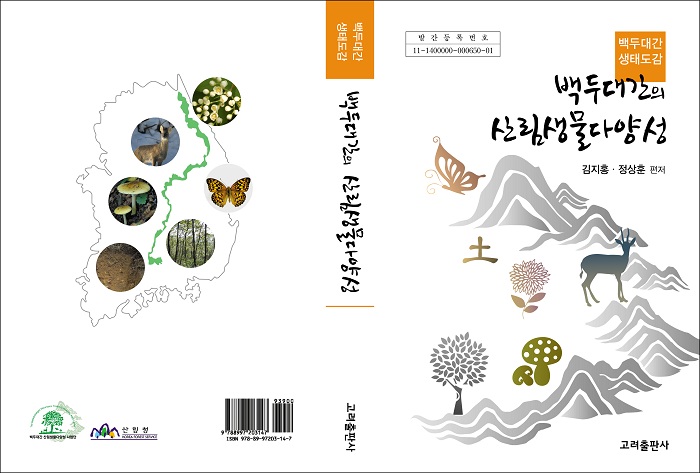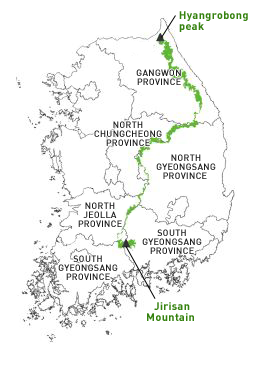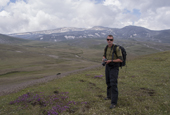A pictorial information book about the wild plants and animals that live along the Baekdudaegan, the backbone mountain range of the Korean Peninsula, has recently been published.
The Korea Forest Service has announced that its photo book, "Forest Biodiversity of the Baekdudaegan" (unofficial translation), has been completed after four years of study. It includes photographs, introductions to and information about 292 species of wild plant, 26 large animal species, 120 types of insect, 100 types of fungus, 19 types of soil and 24 types of vegetation.

The Baekdudaegan mountain range crosses the entire peninsula, from Baekdusan Mountain, now in North Korea, down to Jirisan Mountain in the southern parts of South Korea. It includes the famous Geumgangsan Mountain and Seoraksan Mountain.
The total length of the mountain range solely in South Korea is measured at 701 kilometers. It connects the Hyangrobong peak in Goseong-gun, Gangwon-do, with the Cheonwangbong peak in Sancheong-gun, South Gyeongsang Province.

The mountain range spans six provinces and seven national parks, throughout which are scattered some 487 mountain peaks and passes. Also, being a major pathway and important habitat for all types of creatures and plant life, the undulating mountain range is home to many rare animal species and to pollution-free forests.

Research about the mountain and publication of this volume has been carried out by the Baekdudaegan Forest Biodiversity Research Team, launched in 2010. It consists of 141 people, including professors and students, with master's degrees and doctorates from five universities.
Jeong Sang-hoon, one of the researchers, from the Forest Management Department at Gangwon University, said, "The Baekdudaegan is a treasure trove of biodiversity. Our research team would be happy if this book is used by those who are interested in getting useful and helpful information about the mountain range."
By Lee Seung-ah
Korea.net Staff Writer
slee27@korea.kr
All photos courtesy of Baekdudaegan Forest Biodiversity Research Team
The Korea Forest Service has announced that its photo book, "Forest Biodiversity of the Baekdudaegan" (unofficial translation), has been completed after four years of study. It includes photographs, introductions to and information about 292 species of wild plant, 26 large animal species, 120 types of insect, 100 types of fungus, 19 types of soil and 24 types of vegetation.

The back and cover of "Forest Biodiversity of the Baekdudaegan."
The Baekdudaegan mountain range crosses the entire peninsula, from Baekdusan Mountain, now in North Korea, down to Jirisan Mountain in the southern parts of South Korea. It includes the famous Geumgangsan Mountain and Seoraksan Mountain.
The total length of the mountain range solely in South Korea is measured at 701 kilometers. It connects the Hyangrobong peak in Goseong-gun, Gangwon-do, with the Cheonwangbong peak in Sancheong-gun, South Gyeongsang Province.

The new pictorial guide book provides information about a variety of wild plants and animals living along the Baekdudaegan. Two of them, pictured above, are the Common Serotine (left), a type of bat, and the Yellow Net Mushroom (right).
The mountain range spans six provinces and seven national parks, throughout which are scattered some 487 mountain peaks and passes. Also, being a major pathway and important habitat for all types of creatures and plant life, the undulating mountain range is home to many rare animal species and to pollution-free forests.

The Baekdudaegan crosses the Korean Peninsula from north to south.
Research about the mountain and publication of this volume has been carried out by the Baekdudaegan Forest Biodiversity Research Team, launched in 2010. It consists of 141 people, including professors and students, with master's degrees and doctorates from five universities.
Jeong Sang-hoon, one of the researchers, from the Forest Management Department at Gangwon University, said, "The Baekdudaegan is a treasure trove of biodiversity. Our research team would be happy if this book is used by those who are interested in getting useful and helpful information about the mountain range."
By Lee Seung-ah
Korea.net Staff Writer
slee27@korea.kr
All photos courtesy of Baekdudaegan Forest Biodiversity Research Team
Most popular
- Grammy-winning producer calls Suga of BTS 'amazing artist'
- 'Universal love, family' themes fuel success of 'King of Kings': director
- Council sets minimum hourly wage in 2026 at KRW 10,320
- Songs from animated K-pop film rule Spotify daily chart in US
- Exhibition 'K-Comics World' hawks webtoons in 5 countries


